Business and the Business Environment: M&S Case Study Analysis
VerifiedAdded on 2023/01/06
|14
|3750
|82
Report
AI Summary
This report provides a comprehensive analysis of the business environment, focusing on the British retailer Marks & Spencer (M&S). It begins by defining the business environment and its impact on organizational performance. The report then explores different types of organizations, including private, public, and voluntary sectors, detailing their characteristics, goals, and legal features. It also examines the size and scope of organizations, illustrating these concepts with examples like Ma Baker, NHS, and Oxfam. The report delves into organizational structures, such as functional, matrix, and strategic business units, using M&S as a case study, and illustrating the interrelationships between functional departments like marketing, finance, and R&D. Furthermore, the report applies PESTEL analysis to assess the political, economic, socio-cultural, technological, legal, and environmental factors influencing M&S, highlighting both positive and negative impacts. The analysis covers how external factors affect M&S's operations, market position, and overall business strategy, providing a detailed overview of the company's challenges and opportunities within its operating environment.
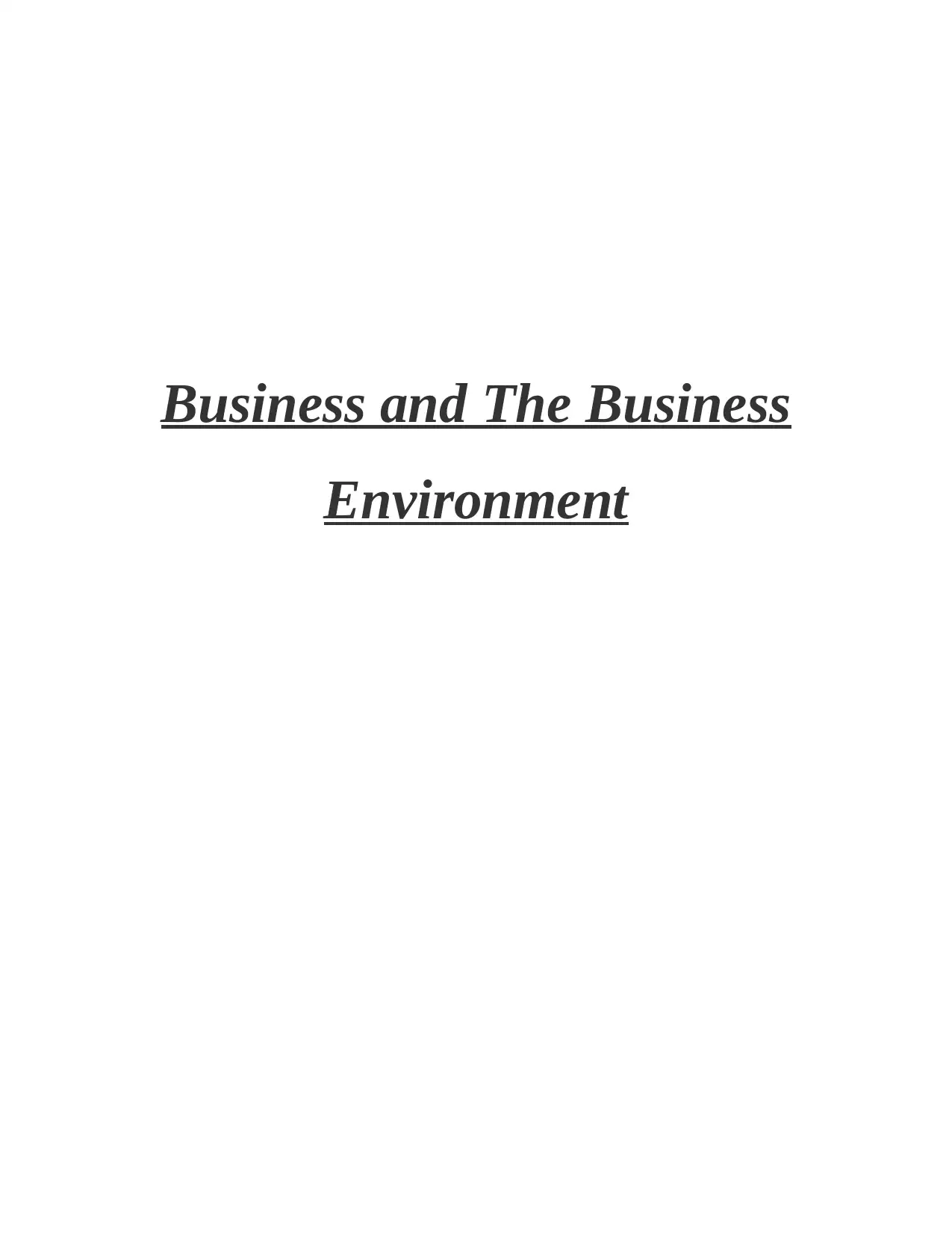
Business and The Business
Environment
Environment
Paraphrase This Document
Need a fresh take? Get an instant paraphrase of this document with our AI Paraphraser
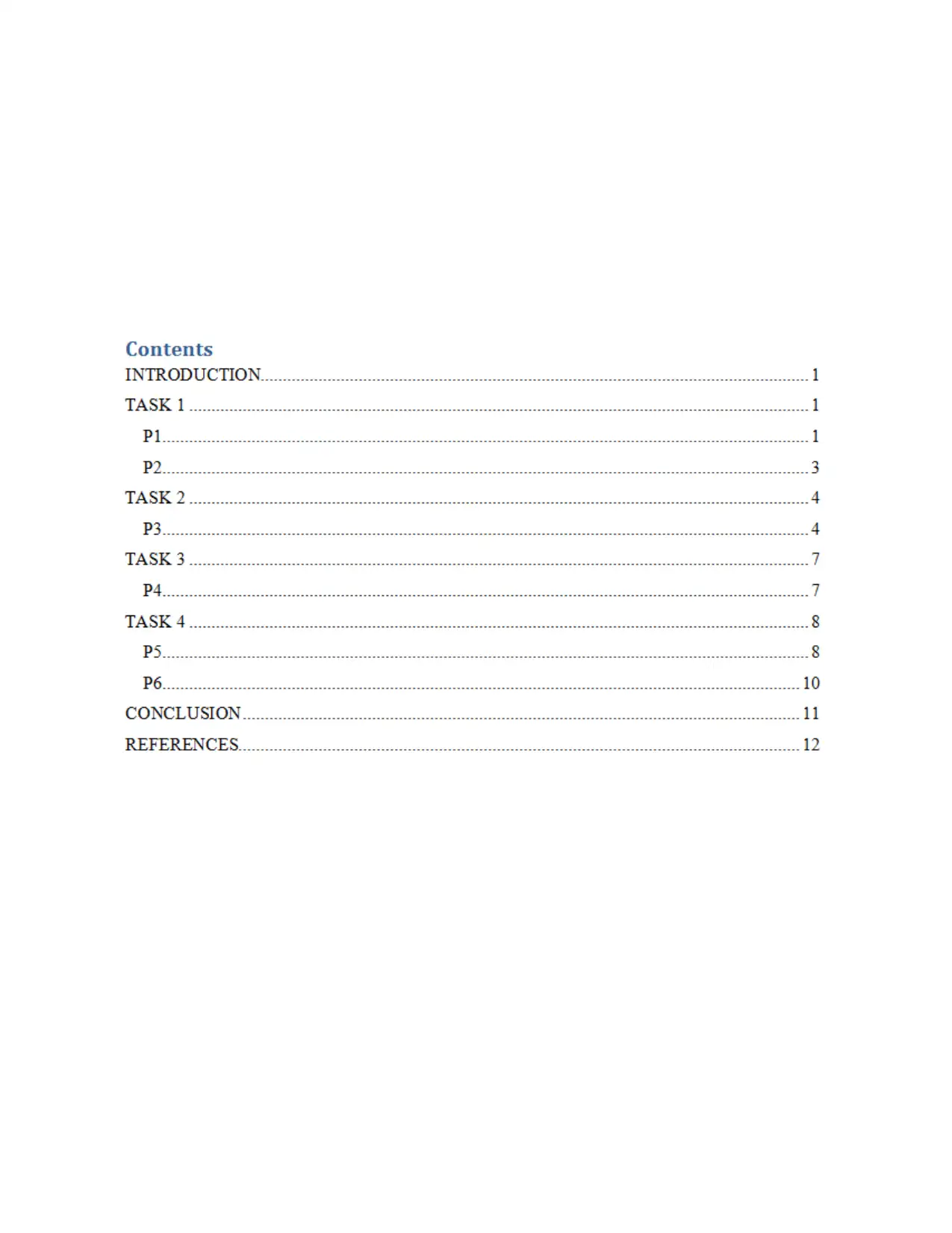
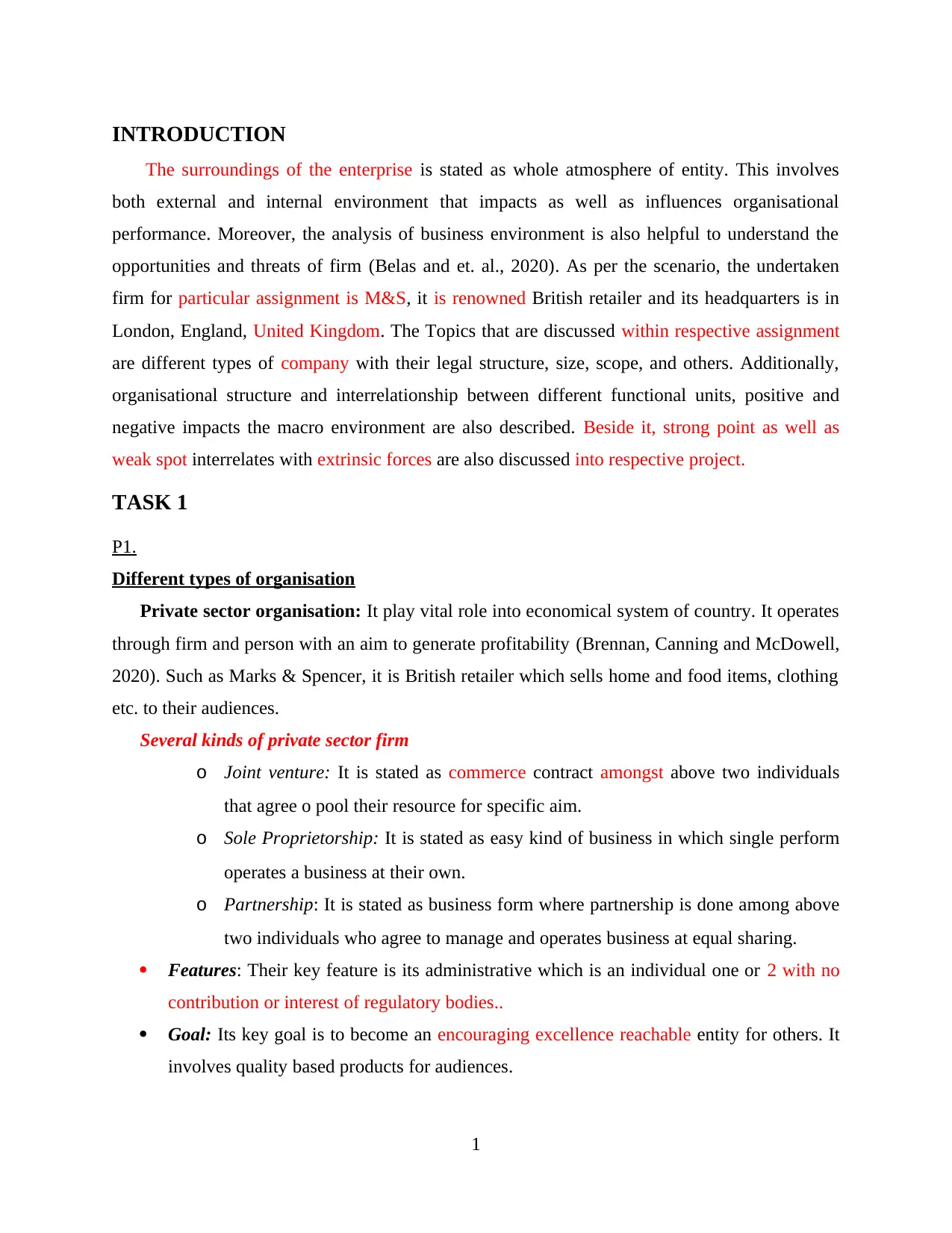
INTRODUCTION
The surroundings of the enterprise is stated as whole atmosphere of entity. This involves
both external and internal environment that impacts as well as influences organisational
performance. Moreover, the analysis of business environment is also helpful to understand the
opportunities and threats of firm (Belas and et. al., 2020). As per the scenario, the undertaken
firm for particular assignment is M&S, it is renowned British retailer and its headquarters is in
London, England, United Kingdom. The Topics that are discussed within respective assignment
are different types of company with their legal structure, size, scope, and others. Additionally,
organisational structure and interrelationship between different functional units, positive and
negative impacts the macro environment are also described. Beside it, strong point as well as
weak spot interrelates with extrinsic forces are also discussed into respective project.
TASK 1
P1.
Different types of organisation
Private sector organisation: It play vital role into economical system of country. It operates
through firm and person with an aim to generate profitability (Brennan, Canning and McDowell,
2020). Such as Marks & Spencer, it is British retailer which sells home and food items, clothing
etc. to their audiences.
Several kinds of private sector firm
o Joint venture: It is stated as commerce contract amongst above two individuals
that agree o pool their resource for specific aim.
o Sole Proprietorship: It is stated as easy kind of business in which single perform
operates a business at their own.
o Partnership: It is stated as business form where partnership is done among above
two individuals who agree to manage and operates business at equal sharing.
Features: Their key feature is its administrative which is an individual one or 2 with no
contribution or interest of regulatory bodies..
Goal: Its key goal is to become an encouraging excellence reachable entity for others. It
involves quality based products for audiences.
1
The surroundings of the enterprise is stated as whole atmosphere of entity. This involves
both external and internal environment that impacts as well as influences organisational
performance. Moreover, the analysis of business environment is also helpful to understand the
opportunities and threats of firm (Belas and et. al., 2020). As per the scenario, the undertaken
firm for particular assignment is M&S, it is renowned British retailer and its headquarters is in
London, England, United Kingdom. The Topics that are discussed within respective assignment
are different types of company with their legal structure, size, scope, and others. Additionally,
organisational structure and interrelationship between different functional units, positive and
negative impacts the macro environment are also described. Beside it, strong point as well as
weak spot interrelates with extrinsic forces are also discussed into respective project.
TASK 1
P1.
Different types of organisation
Private sector organisation: It play vital role into economical system of country. It operates
through firm and person with an aim to generate profitability (Brennan, Canning and McDowell,
2020). Such as Marks & Spencer, it is British retailer which sells home and food items, clothing
etc. to their audiences.
Several kinds of private sector firm
o Joint venture: It is stated as commerce contract amongst above two individuals
that agree o pool their resource for specific aim.
o Sole Proprietorship: It is stated as easy kind of business in which single perform
operates a business at their own.
o Partnership: It is stated as business form where partnership is done among above
two individuals who agree to manage and operates business at equal sharing.
Features: Their key feature is its administrative which is an individual one or 2 with no
contribution or interest of regulatory bodies..
Goal: Its key goal is to become an encouraging excellence reachable entity for others. It
involves quality based products for audiences.
1
⊘ This is a preview!⊘
Do you want full access?
Subscribe today to unlock all pages.

Trusted by 1+ million students worldwide
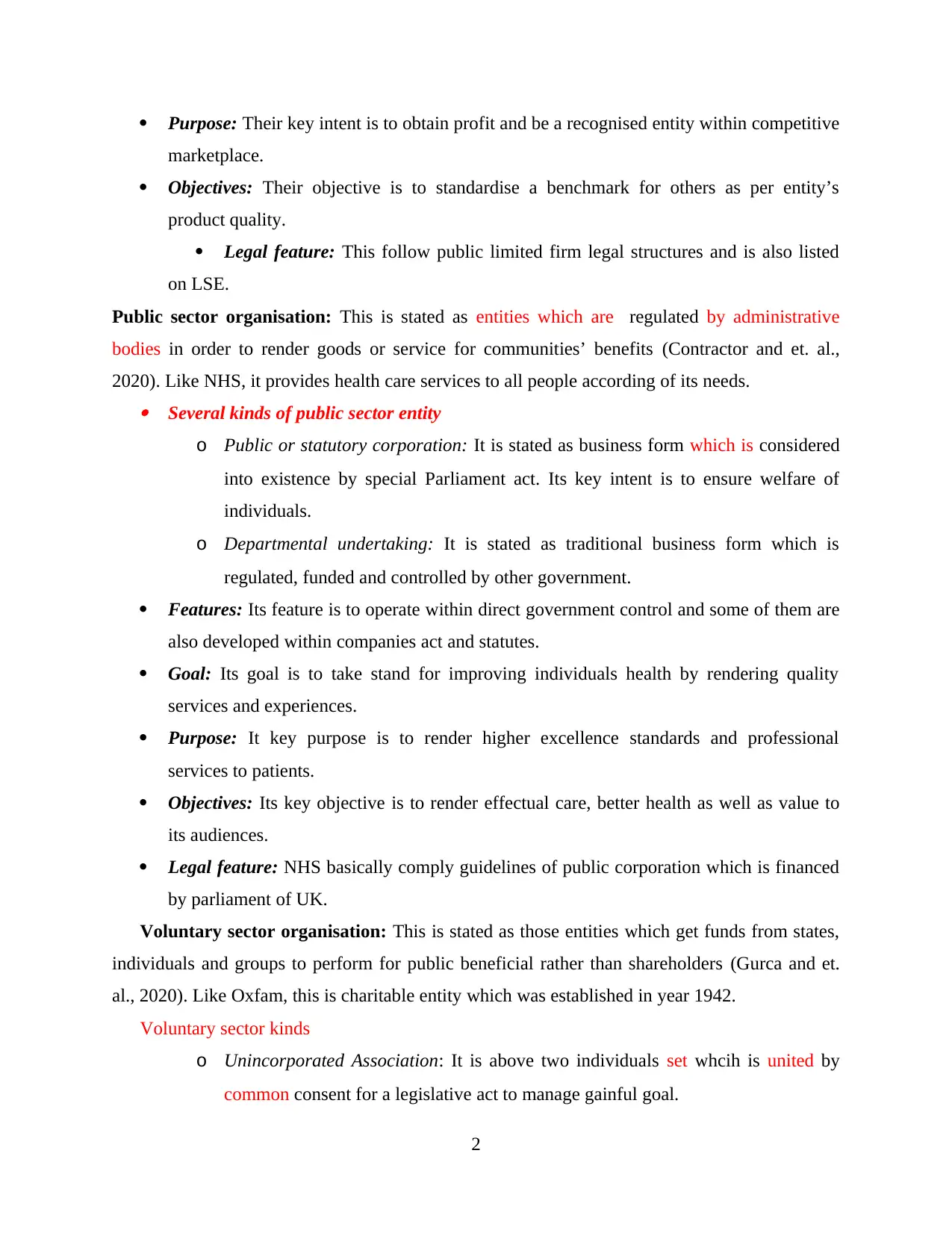
Purpose: Their key intent is to obtain profit and be a recognised entity within competitive
marketplace.
Objectives: Their objective is to standardise a benchmark for others as per entity’s
product quality.
Legal feature: This follow public limited firm legal structures and is also listed
on LSE.
Public sector organisation: This is stated as entities which are regulated by administrative
bodies in order to render goods or service for communities’ benefits (Contractor and et. al.,
2020). Like NHS, it provides health care services to all people according of its needs. Several kinds of public sector entity
o Public or statutory corporation: It is stated as business form which is considered
into existence by special Parliament act. Its key intent is to ensure welfare of
individuals.
o Departmental undertaking: It is stated as traditional business form which is
regulated, funded and controlled by other government.
Features: Its feature is to operate within direct government control and some of them are
also developed within companies act and statutes.
Goal: Its goal is to take stand for improving individuals health by rendering quality
services and experiences.
Purpose: It key purpose is to render higher excellence standards and professional
services to patients.
Objectives: Its key objective is to render effectual care, better health as well as value to
its audiences.
Legal feature: NHS basically comply guidelines of public corporation which is financed
by parliament of UK.
Voluntary sector organisation: This is stated as those entities which get funds from states,
individuals and groups to perform for public beneficial rather than shareholders (Gurca and et.
al., 2020). Like Oxfam, this is charitable entity which was established in year 1942.
Voluntary sector kinds
o Unincorporated Association: It is above two individuals set whcih is united by
common consent for a legislative act to manage gainful goal.
2
marketplace.
Objectives: Their objective is to standardise a benchmark for others as per entity’s
product quality.
Legal feature: This follow public limited firm legal structures and is also listed
on LSE.
Public sector organisation: This is stated as entities which are regulated by administrative
bodies in order to render goods or service for communities’ benefits (Contractor and et. al.,
2020). Like NHS, it provides health care services to all people according of its needs. Several kinds of public sector entity
o Public or statutory corporation: It is stated as business form which is considered
into existence by special Parliament act. Its key intent is to ensure welfare of
individuals.
o Departmental undertaking: It is stated as traditional business form which is
regulated, funded and controlled by other government.
Features: Its feature is to operate within direct government control and some of them are
also developed within companies act and statutes.
Goal: Its goal is to take stand for improving individuals health by rendering quality
services and experiences.
Purpose: It key purpose is to render higher excellence standards and professional
services to patients.
Objectives: Its key objective is to render effectual care, better health as well as value to
its audiences.
Legal feature: NHS basically comply guidelines of public corporation which is financed
by parliament of UK.
Voluntary sector organisation: This is stated as those entities which get funds from states,
individuals and groups to perform for public beneficial rather than shareholders (Gurca and et.
al., 2020). Like Oxfam, this is charitable entity which was established in year 1942.
Voluntary sector kinds
o Unincorporated Association: It is above two individuals set whcih is united by
common consent for a legislative act to manage gainful goal.
2
Paraphrase This Document
Need a fresh take? Get an instant paraphrase of this document with our AI Paraphraser
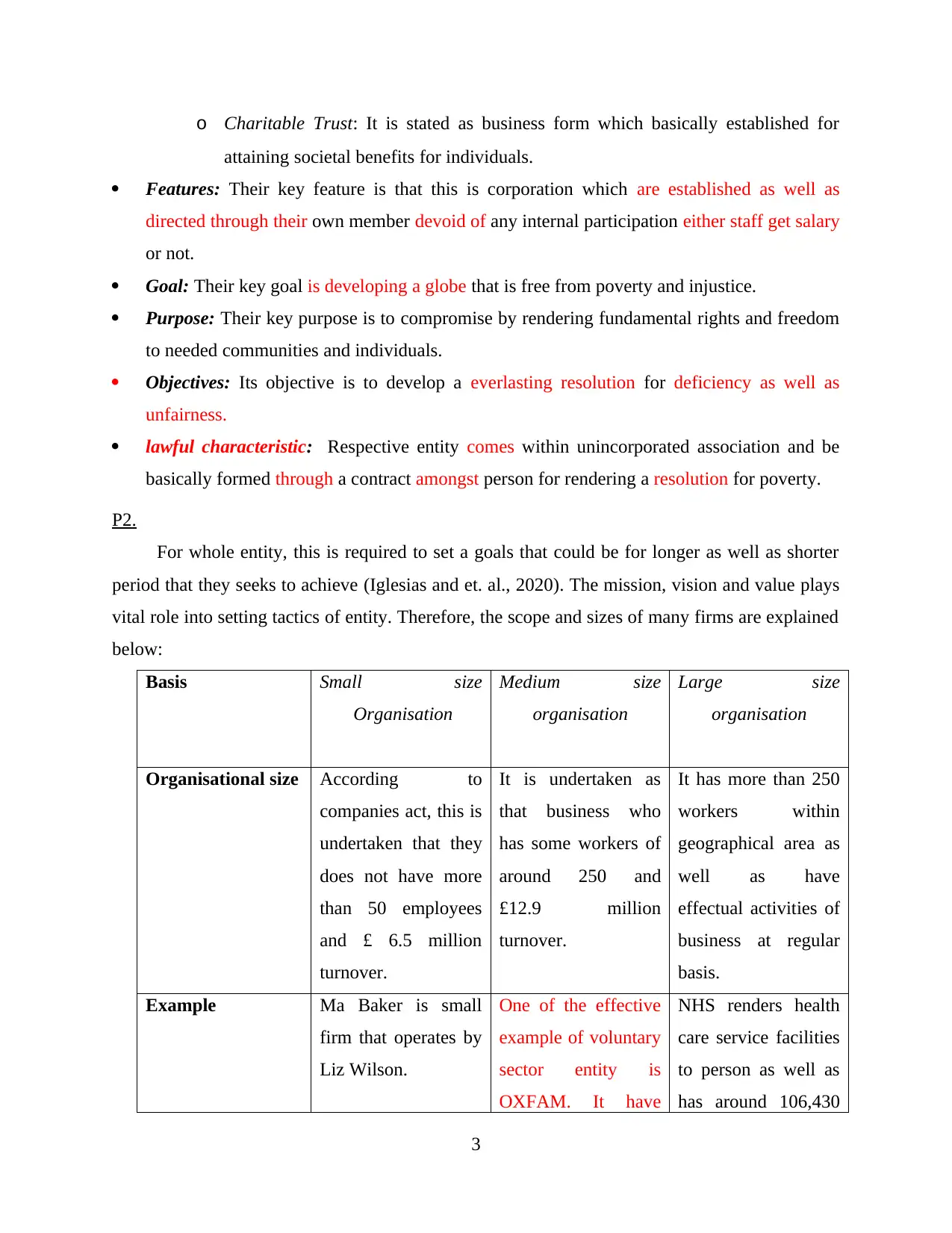
o Charitable Trust: It is stated as business form which basically established for
attaining societal benefits for individuals.
Features: Their key feature is that this is corporation which are established as well as
directed through their own member devoid of any internal participation either staff get salary
or not.
Goal: Their key goal is developing a globe that is free from poverty and injustice.
Purpose: Their key purpose is to compromise by rendering fundamental rights and freedom
to needed communities and individuals.
Objectives: Its objective is to develop a everlasting resolution for deficiency as well as
unfairness.
lawful characteristic: Respective entity comes within unincorporated association and be
basically formed through a contract amongst person for rendering a resolution for poverty.
P2.
For whole entity, this is required to set a goals that could be for longer as well as shorter
period that they seeks to achieve (Iglesias and et. al., 2020). The mission, vision and value plays
vital role into setting tactics of entity. Therefore, the scope and sizes of many firms are explained
below:
Basis Small size
Organisation
Medium size
organisation
Large size
organisation
Organisational size According to
companies act, this is
undertaken that they
does not have more
than 50 employees
and £ 6.5 million
turnover.
It is undertaken as
that business who
has some workers of
around 250 and
£12.9 million
turnover.
It has more than 250
workers within
geographical area as
well as have
effectual activities of
business at regular
basis.
Example Ma Baker is small
firm that operates by
Liz Wilson.
One of the effective
example of voluntary
sector entity is
OXFAM. It have
NHS renders health
care service facilities
to person as well as
has around 106,430
3
attaining societal benefits for individuals.
Features: Their key feature is that this is corporation which are established as well as
directed through their own member devoid of any internal participation either staff get salary
or not.
Goal: Their key goal is developing a globe that is free from poverty and injustice.
Purpose: Their key purpose is to compromise by rendering fundamental rights and freedom
to needed communities and individuals.
Objectives: Its objective is to develop a everlasting resolution for deficiency as well as
unfairness.
lawful characteristic: Respective entity comes within unincorporated association and be
basically formed through a contract amongst person for rendering a resolution for poverty.
P2.
For whole entity, this is required to set a goals that could be for longer as well as shorter
period that they seeks to achieve (Iglesias and et. al., 2020). The mission, vision and value plays
vital role into setting tactics of entity. Therefore, the scope and sizes of many firms are explained
below:
Basis Small size
Organisation
Medium size
organisation
Large size
organisation
Organisational size According to
companies act, this is
undertaken that they
does not have more
than 50 employees
and £ 6.5 million
turnover.
It is undertaken as
that business who
has some workers of
around 250 and
£12.9 million
turnover.
It has more than 250
workers within
geographical area as
well as have
effectual activities of
business at regular
basis.
Example Ma Baker is small
firm that operates by
Liz Wilson.
One of the effective
example of voluntary
sector entity is
OXFAM. It have
NHS renders health
care service facilities
to person as well as
has around 106,430
3
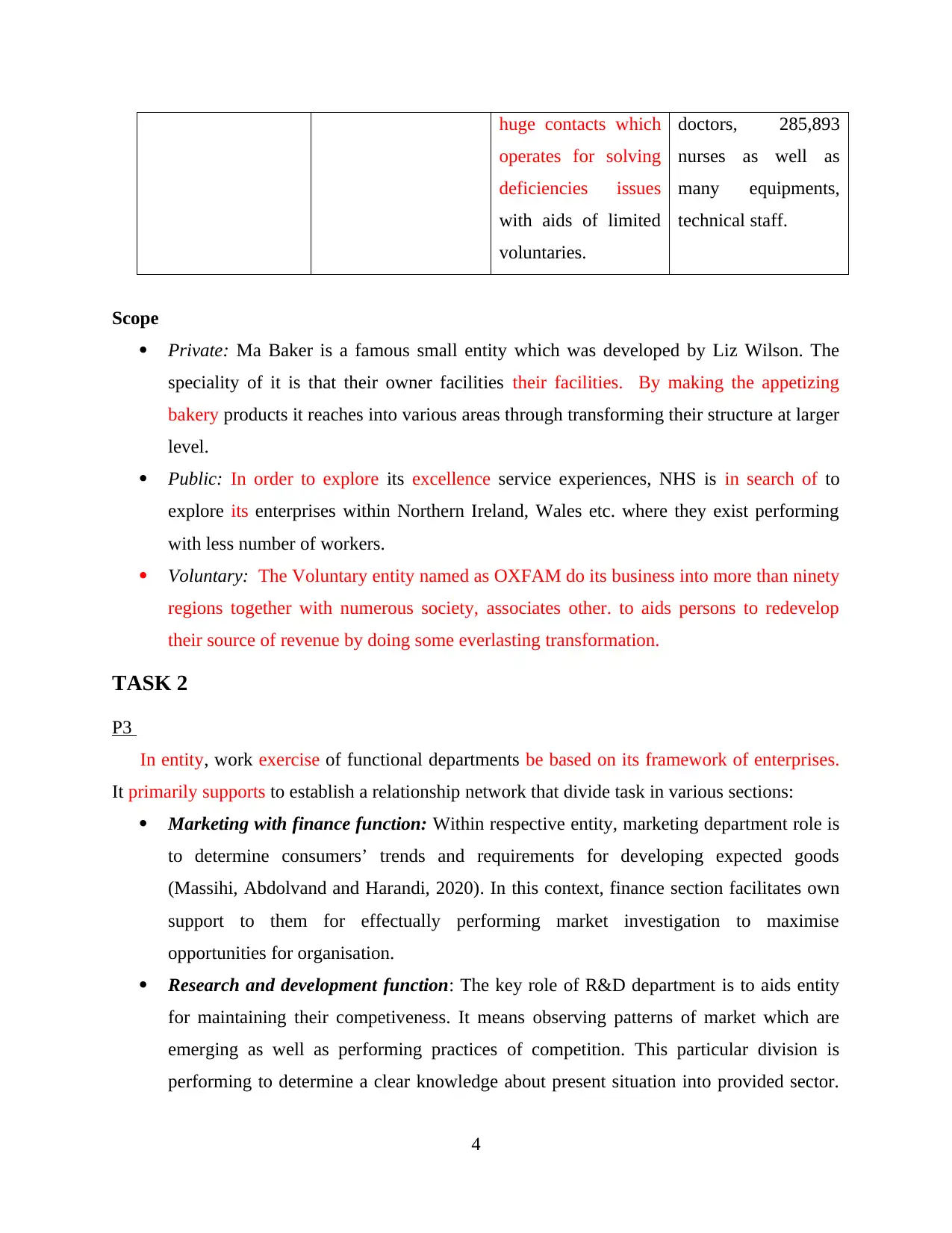
huge contacts which
operates for solving
deficiencies issues
with aids of limited
voluntaries.
doctors, 285,893
nurses as well as
many equipments,
technical staff.
Scope
Private: Ma Baker is a famous small entity which was developed by Liz Wilson. The
speciality of it is that their owner facilities their facilities. By making the appetizing
bakery products it reaches into various areas through transforming their structure at larger
level.
Public: In order to explore its excellence service experiences, NHS is in search of to
explore its enterprises within Northern Ireland, Wales etc. where they exist performing
with less number of workers.
Voluntary: The Voluntary entity named as OXFAM do its business into more than ninety
regions together with numerous society, associates other. to aids persons to redevelop
their source of revenue by doing some everlasting transformation.
TASK 2
P3
In entity, work exercise of functional departments be based on its framework of enterprises.
It primarily supports to establish a relationship network that divide task in various sections:
Marketing with finance function: Within respective entity, marketing department role is
to determine consumers’ trends and requirements for developing expected goods
(Massihi, Abdolvand and Harandi, 2020). In this context, finance section facilitates own
support to them for effectually performing market investigation to maximise
opportunities for organisation.
Research and development function: The key role of R&D department is to aids entity
for maintaining their competiveness. It means observing patterns of market which are
emerging as well as performing practices of competition. This particular division is
performing to determine a clear knowledge about present situation into provided sector.
4
operates for solving
deficiencies issues
with aids of limited
voluntaries.
doctors, 285,893
nurses as well as
many equipments,
technical staff.
Scope
Private: Ma Baker is a famous small entity which was developed by Liz Wilson. The
speciality of it is that their owner facilities their facilities. By making the appetizing
bakery products it reaches into various areas through transforming their structure at larger
level.
Public: In order to explore its excellence service experiences, NHS is in search of to
explore its enterprises within Northern Ireland, Wales etc. where they exist performing
with less number of workers.
Voluntary: The Voluntary entity named as OXFAM do its business into more than ninety
regions together with numerous society, associates other. to aids persons to redevelop
their source of revenue by doing some everlasting transformation.
TASK 2
P3
In entity, work exercise of functional departments be based on its framework of enterprises.
It primarily supports to establish a relationship network that divide task in various sections:
Marketing with finance function: Within respective entity, marketing department role is
to determine consumers’ trends and requirements for developing expected goods
(Massihi, Abdolvand and Harandi, 2020). In this context, finance section facilitates own
support to them for effectually performing market investigation to maximise
opportunities for organisation.
Research and development function: The key role of R&D department is to aids entity
for maintaining their competiveness. It means observing patterns of market which are
emerging as well as performing practices of competition. This particular division is
performing to determine a clear knowledge about present situation into provided sector.
4
⊘ This is a preview!⊘
Do you want full access?
Subscribe today to unlock all pages.

Trusted by 1+ million students worldwide
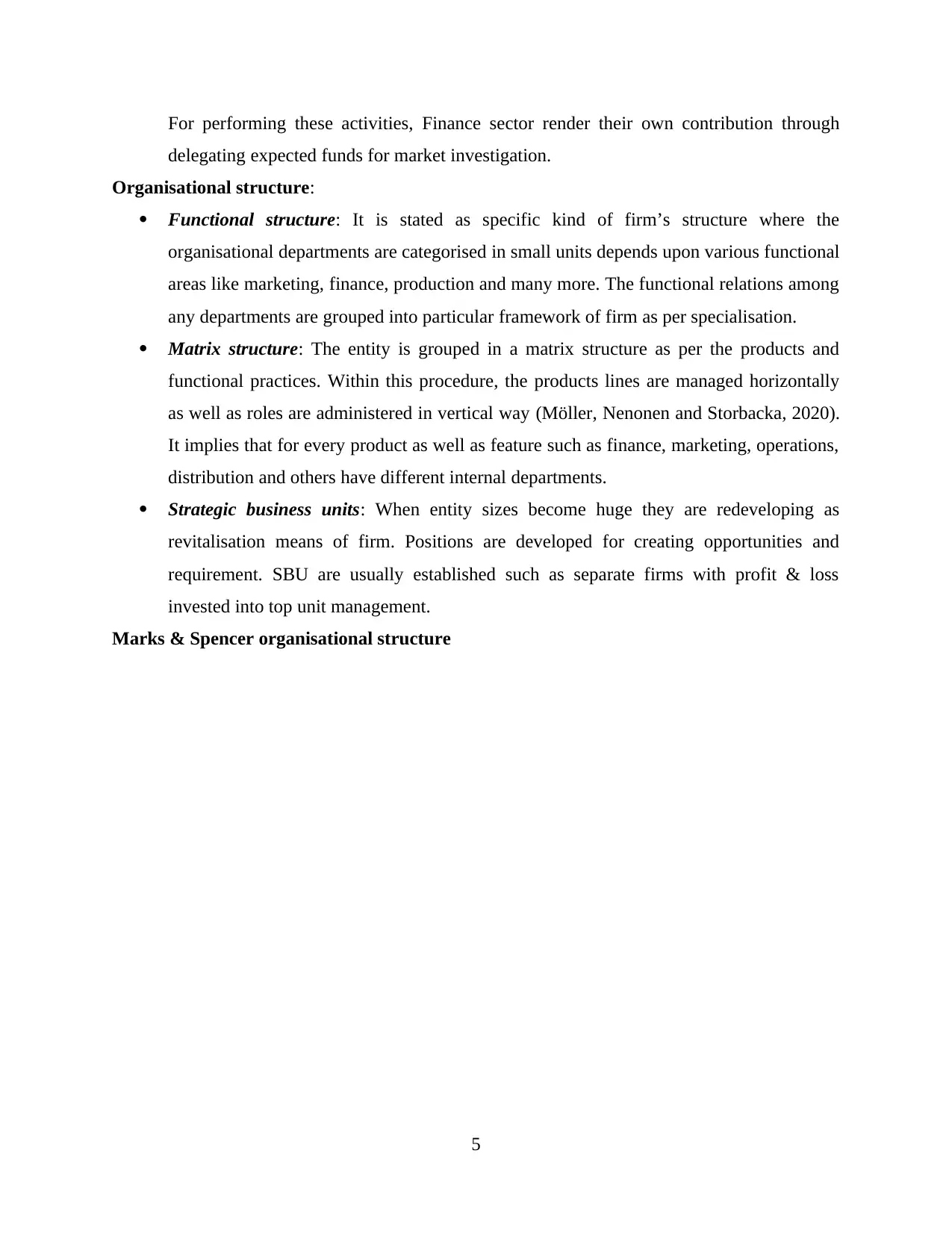
For performing these activities, Finance sector render their own contribution through
delegating expected funds for market investigation.
Organisational structure:
Functional structure: It is stated as specific kind of firm’s structure where the
organisational departments are categorised in small units depends upon various functional
areas like marketing, finance, production and many more. The functional relations among
any departments are grouped into particular framework of firm as per specialisation.
Matrix structure: The entity is grouped in a matrix structure as per the products and
functional practices. Within this procedure, the products lines are managed horizontally
as well as roles are administered in vertical way (Möller, Nenonen and Storbacka, 2020).
It implies that for every product as well as feature such as finance, marketing, operations,
distribution and others have different internal departments.
Strategic business units: When entity sizes become huge they are redeveloping as
revitalisation means of firm. Positions are developed for creating opportunities and
requirement. SBU are usually established such as separate firms with profit & loss
invested into top unit management.
Marks & Spencer organisational structure
5
delegating expected funds for market investigation.
Organisational structure:
Functional structure: It is stated as specific kind of firm’s structure where the
organisational departments are categorised in small units depends upon various functional
areas like marketing, finance, production and many more. The functional relations among
any departments are grouped into particular framework of firm as per specialisation.
Matrix structure: The entity is grouped in a matrix structure as per the products and
functional practices. Within this procedure, the products lines are managed horizontally
as well as roles are administered in vertical way (Möller, Nenonen and Storbacka, 2020).
It implies that for every product as well as feature such as finance, marketing, operations,
distribution and others have different internal departments.
Strategic business units: When entity sizes become huge they are redeveloping as
revitalisation means of firm. Positions are developed for creating opportunities and
requirement. SBU are usually established such as separate firms with profit & loss
invested into top unit management.
Marks & Spencer organisational structure
5
Paraphrase This Document
Need a fresh take? Get an instant paraphrase of this document with our AI Paraphraser
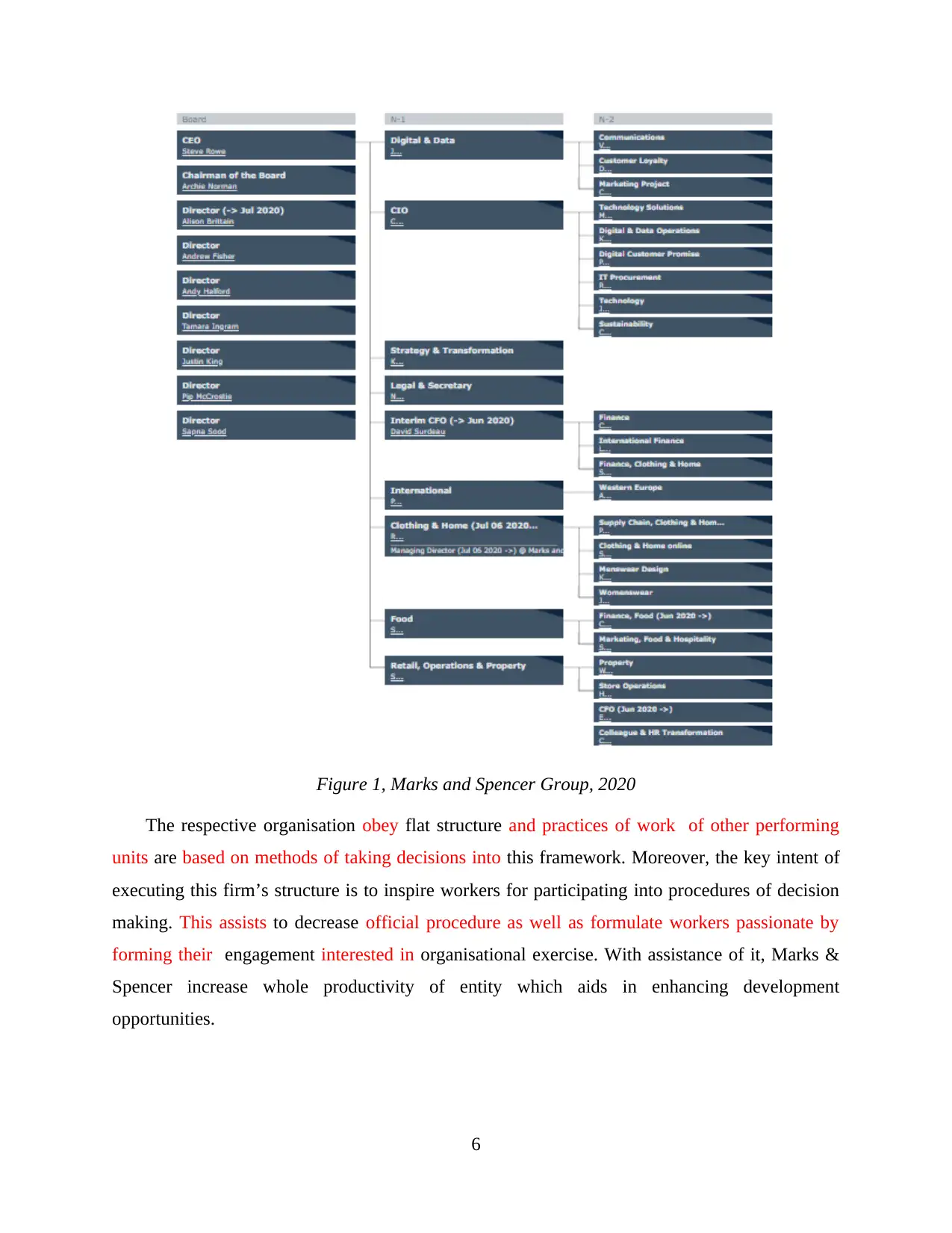
Figure 1, Marks and Spencer Group, 2020
The respective organisation obey flat structure and practices of work of other performing
units are based on methods of taking decisions into this framework. Moreover, the key intent of
executing this firm’s structure is to inspire workers for participating into procedures of decision
making. This assists to decrease official procedure as well as formulate workers passionate by
forming their engagement interested in organisational exercise. With assistance of it, Marks &
Spencer increase whole productivity of entity which aids in enhancing development
opportunities.
6
The respective organisation obey flat structure and practices of work of other performing
units are based on methods of taking decisions into this framework. Moreover, the key intent of
executing this firm’s structure is to inspire workers for participating into procedures of decision
making. This assists to decrease official procedure as well as formulate workers passionate by
forming their engagement interested in organisational exercise. With assistance of it, Marks &
Spencer increase whole productivity of entity which aids in enhancing development
opportunities.
6
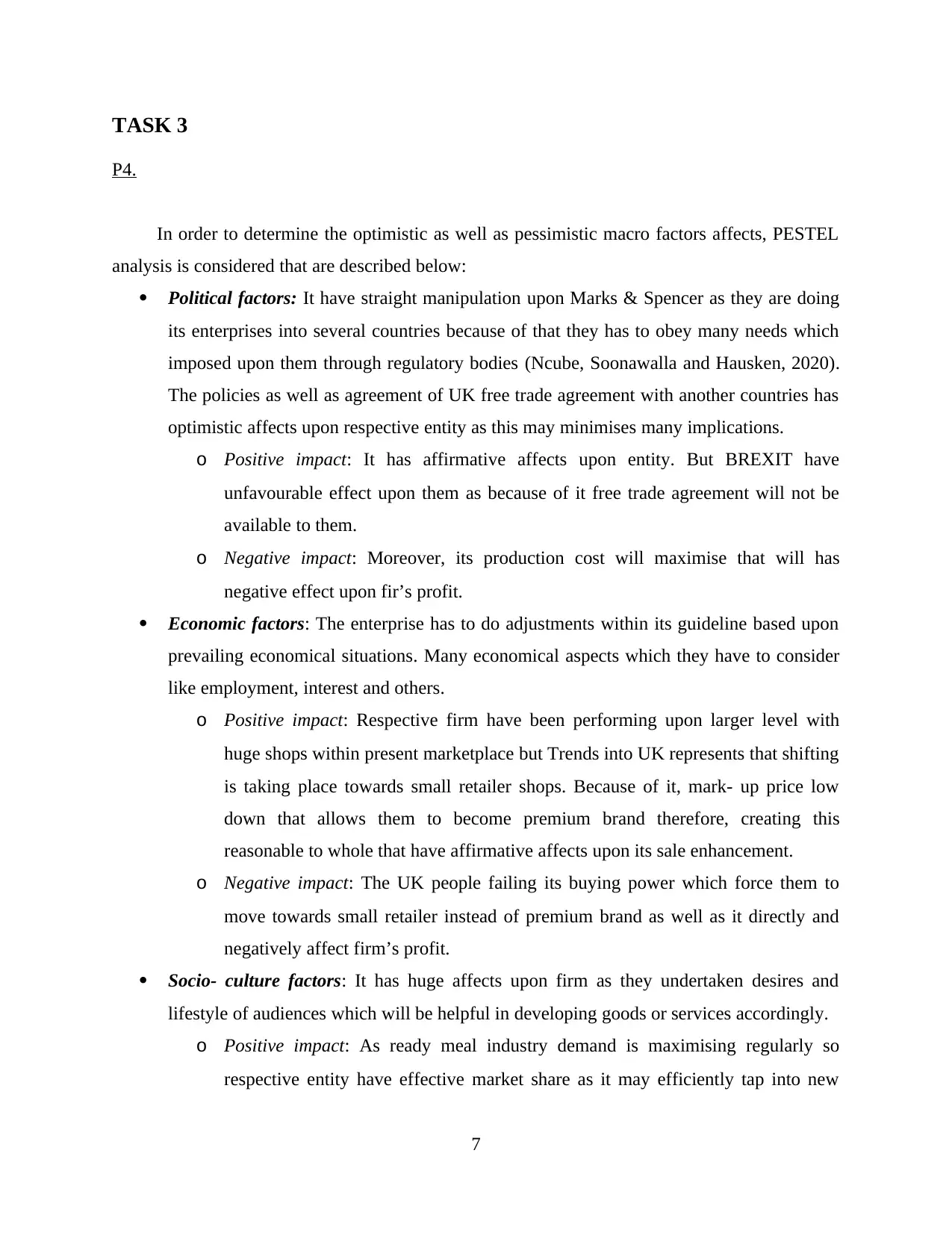
TASK 3
P4.
In order to determine the optimistic as well as pessimistic macro factors affects, PESTEL
analysis is considered that are described below:
Political factors: It have straight manipulation upon Marks & Spencer as they are doing
its enterprises into several countries because of that they has to obey many needs which
imposed upon them through regulatory bodies (Ncube, Soonawalla and Hausken, 2020).
The policies as well as agreement of UK free trade agreement with another countries has
optimistic affects upon respective entity as this may minimises many implications.
o Positive impact: It has affirmative affects upon entity. But BREXIT have
unfavourable effect upon them as because of it free trade agreement will not be
available to them.
o Negative impact: Moreover, its production cost will maximise that will has
negative effect upon fir’s profit.
Economic factors: The enterprise has to do adjustments within its guideline based upon
prevailing economical situations. Many economical aspects which they have to consider
like employment, interest and others.
o Positive impact: Respective firm have been performing upon larger level with
huge shops within present marketplace but Trends into UK represents that shifting
is taking place towards small retailer shops. Because of it, mark- up price low
down that allows them to become premium brand therefore, creating this
reasonable to whole that have affirmative affects upon its sale enhancement.
o Negative impact: The UK people failing its buying power which force them to
move towards small retailer instead of premium brand as well as it directly and
negatively affect firm’s profit.
Socio- culture factors: It has huge affects upon firm as they undertaken desires and
lifestyle of audiences which will be helpful in developing goods or services accordingly.
o Positive impact: As ready meal industry demand is maximising regularly so
respective entity have effective market share as it may efficiently tap into new
7
P4.
In order to determine the optimistic as well as pessimistic macro factors affects, PESTEL
analysis is considered that are described below:
Political factors: It have straight manipulation upon Marks & Spencer as they are doing
its enterprises into several countries because of that they has to obey many needs which
imposed upon them through regulatory bodies (Ncube, Soonawalla and Hausken, 2020).
The policies as well as agreement of UK free trade agreement with another countries has
optimistic affects upon respective entity as this may minimises many implications.
o Positive impact: It has affirmative affects upon entity. But BREXIT have
unfavourable effect upon them as because of it free trade agreement will not be
available to them.
o Negative impact: Moreover, its production cost will maximise that will has
negative effect upon fir’s profit.
Economic factors: The enterprise has to do adjustments within its guideline based upon
prevailing economical situations. Many economical aspects which they have to consider
like employment, interest and others.
o Positive impact: Respective firm have been performing upon larger level with
huge shops within present marketplace but Trends into UK represents that shifting
is taking place towards small retailer shops. Because of it, mark- up price low
down that allows them to become premium brand therefore, creating this
reasonable to whole that have affirmative affects upon its sale enhancement.
o Negative impact: The UK people failing its buying power which force them to
move towards small retailer instead of premium brand as well as it directly and
negatively affect firm’s profit.
Socio- culture factors: It has huge affects upon firm as they undertaken desires and
lifestyle of audiences which will be helpful in developing goods or services accordingly.
o Positive impact: As ready meal industry demand is maximising regularly so
respective entity have effective market share as it may efficiently tap into new
7
⊘ This is a preview!⊘
Do you want full access?
Subscribe today to unlock all pages.

Trusted by 1+ million students worldwide
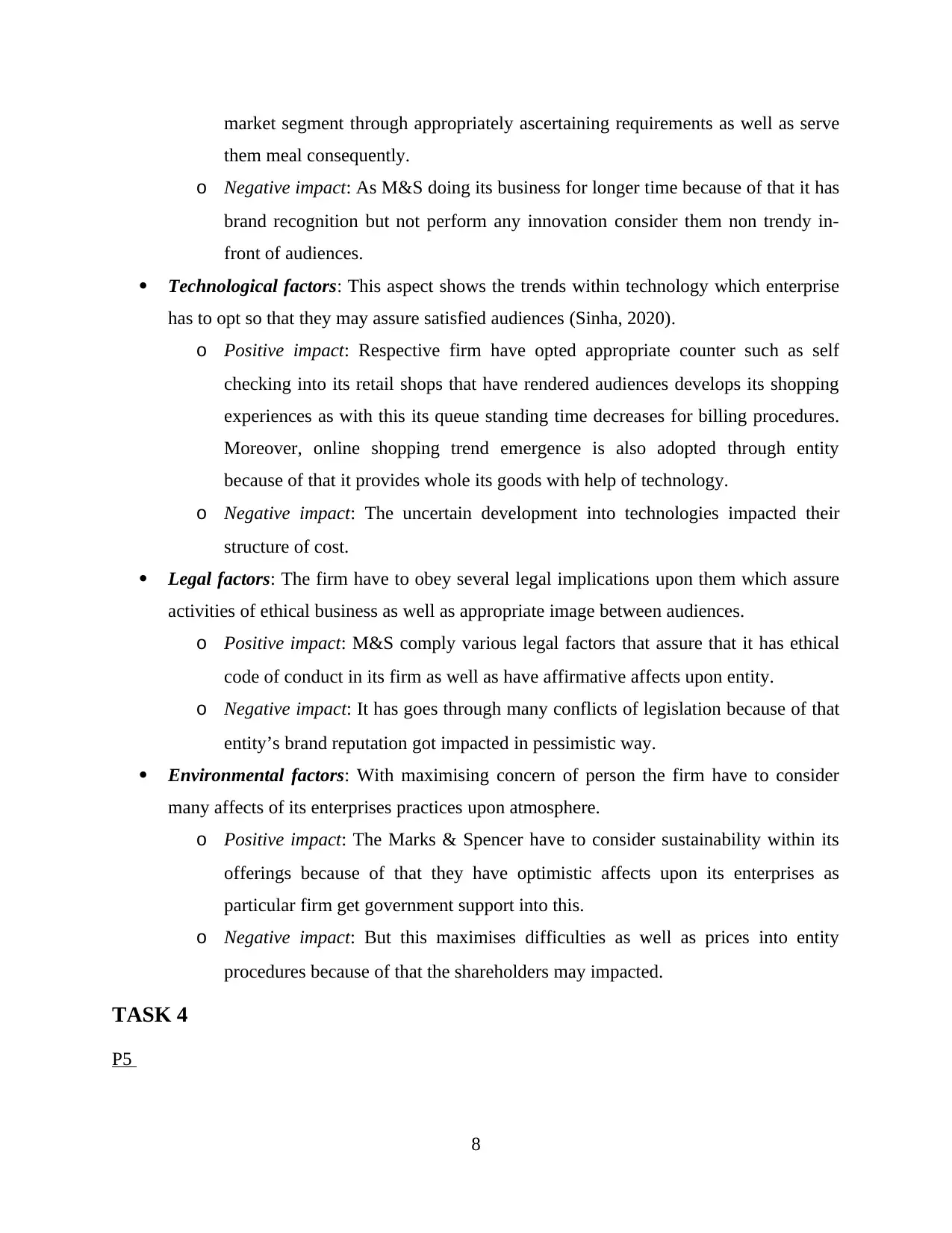
market segment through appropriately ascertaining requirements as well as serve
them meal consequently.
o Negative impact: As M&S doing its business for longer time because of that it has
brand recognition but not perform any innovation consider them non trendy in-
front of audiences.
Technological factors: This aspect shows the trends within technology which enterprise
has to opt so that they may assure satisfied audiences (Sinha, 2020).
o Positive impact: Respective firm have opted appropriate counter such as self
checking into its retail shops that have rendered audiences develops its shopping
experiences as with this its queue standing time decreases for billing procedures.
Moreover, online shopping trend emergence is also adopted through entity
because of that it provides whole its goods with help of technology.
o Negative impact: The uncertain development into technologies impacted their
structure of cost.
Legal factors: The firm have to obey several legal implications upon them which assure
activities of ethical business as well as appropriate image between audiences.
o Positive impact: M&S comply various legal factors that assure that it has ethical
code of conduct in its firm as well as have affirmative affects upon entity.
o Negative impact: It has goes through many conflicts of legislation because of that
entity’s brand reputation got impacted in pessimistic way.
Environmental factors: With maximising concern of person the firm have to consider
many affects of its enterprises practices upon atmosphere.
o Positive impact: The Marks & Spencer have to consider sustainability within its
offerings because of that they have optimistic affects upon its enterprises as
particular firm get government support into this.
o Negative impact: But this maximises difficulties as well as prices into entity
procedures because of that the shareholders may impacted.
TASK 4
P5
8
them meal consequently.
o Negative impact: As M&S doing its business for longer time because of that it has
brand recognition but not perform any innovation consider them non trendy in-
front of audiences.
Technological factors: This aspect shows the trends within technology which enterprise
has to opt so that they may assure satisfied audiences (Sinha, 2020).
o Positive impact: Respective firm have opted appropriate counter such as self
checking into its retail shops that have rendered audiences develops its shopping
experiences as with this its queue standing time decreases for billing procedures.
Moreover, online shopping trend emergence is also adopted through entity
because of that it provides whole its goods with help of technology.
o Negative impact: The uncertain development into technologies impacted their
structure of cost.
Legal factors: The firm have to obey several legal implications upon them which assure
activities of ethical business as well as appropriate image between audiences.
o Positive impact: M&S comply various legal factors that assure that it has ethical
code of conduct in its firm as well as have affirmative affects upon entity.
o Negative impact: It has goes through many conflicts of legislation because of that
entity’s brand reputation got impacted in pessimistic way.
Environmental factors: With maximising concern of person the firm have to consider
many affects of its enterprises practices upon atmosphere.
o Positive impact: The Marks & Spencer have to consider sustainability within its
offerings because of that they have optimistic affects upon its enterprises as
particular firm get government support into this.
o Negative impact: But this maximises difficulties as well as prices into entity
procedures because of that the shareholders may impacted.
TASK 4
P5
8
Paraphrase This Document
Need a fresh take? Get an instant paraphrase of this document with our AI Paraphraser
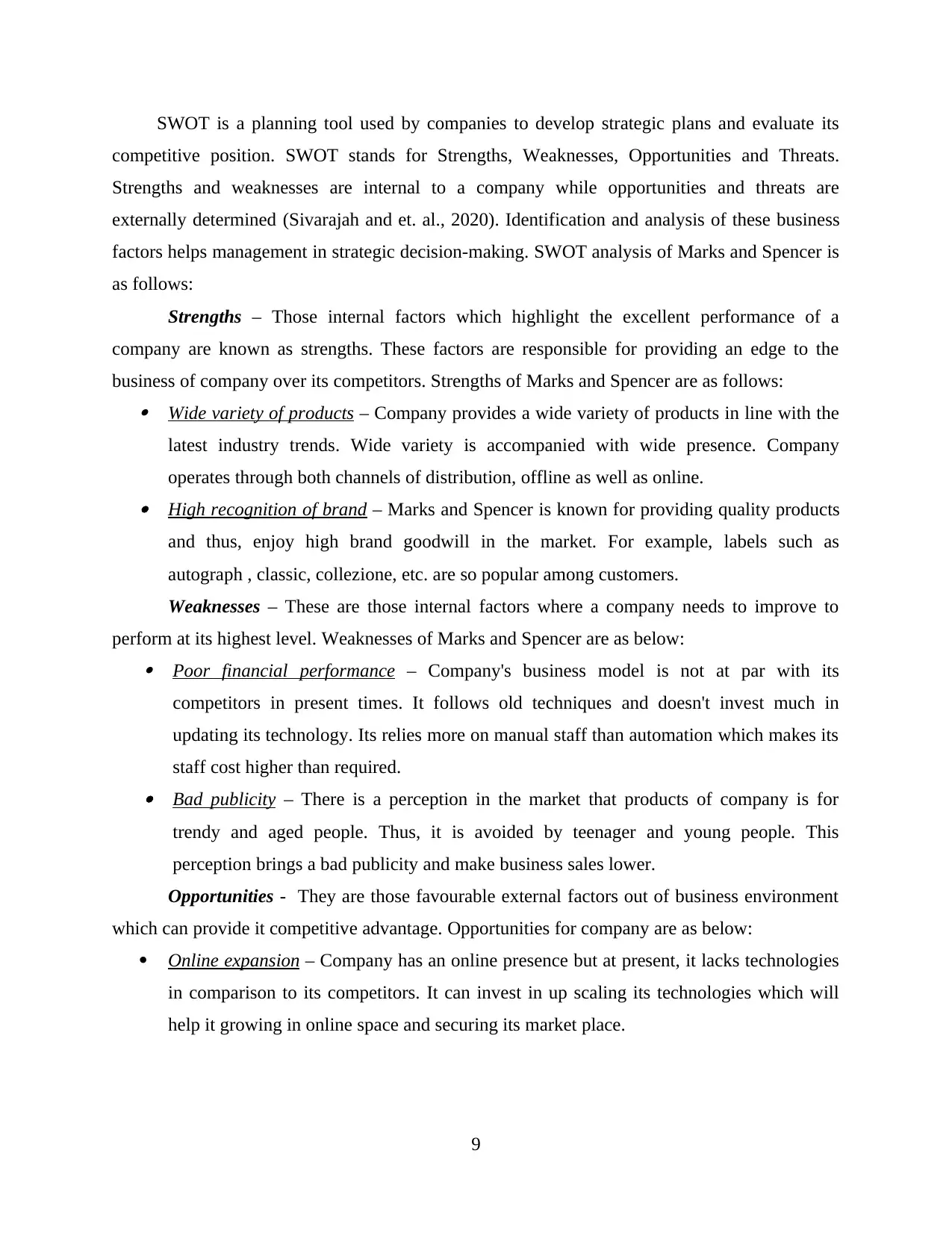
SWOT is a planning tool used by companies to develop strategic plans and evaluate its
competitive position. SWOT stands for Strengths, Weaknesses, Opportunities and Threats.
Strengths and weaknesses are internal to a company while opportunities and threats are
externally determined (Sivarajah and et. al., 2020). Identification and analysis of these business
factors helps management in strategic decision-making. SWOT analysis of Marks and Spencer is
as follows:
Strengths – Those internal factors which highlight the excellent performance of a
company are known as strengths. These factors are responsible for providing an edge to the
business of company over its competitors. Strengths of Marks and Spencer are as follows: Wide variety of products – Company provides a wide variety of products in line with the
latest industry trends. Wide variety is accompanied with wide presence. Company
operates through both channels of distribution, offline as well as online. High recognition of brand – Marks and Spencer is known for providing quality products
and thus, enjoy high brand goodwill in the market. For example, labels such as
autograph , classic, collezione, etc. are so popular among customers.
Weaknesses – These are those internal factors where a company needs to improve to
perform at its highest level. Weaknesses of Marks and Spencer are as below: Poor financial performance – Company's business model is not at par with its
competitors in present times. It follows old techniques and doesn't invest much in
updating its technology. Its relies more on manual staff than automation which makes its
staff cost higher than required. Bad publicity – There is a perception in the market that products of company is for
trendy and aged people. Thus, it is avoided by teenager and young people. This
perception brings a bad publicity and make business sales lower.
Opportunities - They are those favourable external factors out of business environment
which can provide it competitive advantage. Opportunities for company are as below:
Online expansion – Company has an online presence but at present, it lacks technologies
in comparison to its competitors. It can invest in up scaling its technologies which will
help it growing in online space and securing its market place.
9
competitive position. SWOT stands for Strengths, Weaknesses, Opportunities and Threats.
Strengths and weaknesses are internal to a company while opportunities and threats are
externally determined (Sivarajah and et. al., 2020). Identification and analysis of these business
factors helps management in strategic decision-making. SWOT analysis of Marks and Spencer is
as follows:
Strengths – Those internal factors which highlight the excellent performance of a
company are known as strengths. These factors are responsible for providing an edge to the
business of company over its competitors. Strengths of Marks and Spencer are as follows: Wide variety of products – Company provides a wide variety of products in line with the
latest industry trends. Wide variety is accompanied with wide presence. Company
operates through both channels of distribution, offline as well as online. High recognition of brand – Marks and Spencer is known for providing quality products
and thus, enjoy high brand goodwill in the market. For example, labels such as
autograph , classic, collezione, etc. are so popular among customers.
Weaknesses – These are those internal factors where a company needs to improve to
perform at its highest level. Weaknesses of Marks and Spencer are as below: Poor financial performance – Company's business model is not at par with its
competitors in present times. It follows old techniques and doesn't invest much in
updating its technology. Its relies more on manual staff than automation which makes its
staff cost higher than required. Bad publicity – There is a perception in the market that products of company is for
trendy and aged people. Thus, it is avoided by teenager and young people. This
perception brings a bad publicity and make business sales lower.
Opportunities - They are those favourable external factors out of business environment
which can provide it competitive advantage. Opportunities for company are as below:
Online expansion – Company has an online presence but at present, it lacks technologies
in comparison to its competitors. It can invest in up scaling its technologies which will
help it growing in online space and securing its market place.
9

Reshaping clothing policies – Companies is not famous in youngsters. It can design a
new clothing line specially aiming at fashion of teenagers and youngster. It can also
reshape its marketing strategies to attract new customers.
Threats – These refer to those potential external factors which can harm business and
operations of an organisation. Threats to company are as below:
Increased competition – Industry in which company operates has cut-throat competition
from its competitors such as Asda, Tesco and Sainsbury and most of them have their
loyal customer base. Increasing presence in such industry is a very difficult task for any
organisation (Trigkas and et. al., 2020).
Government policies – Company operates in many countries of the world and has to put
up with legal and political liabilities of different markets. Any lag can result in lawsuit
which would result in unnecessary costs.
P6.
The firm have to determine their business opportunities which will be helpful in attaining
organisational goals and reduces many prevailing threats (Wanke and et. al., 2020). The
interrelations among micro and macro aspects are described below:
External factors
Political Strengths: Respective entity is already a well recognised brand and having
government support which aids them to extend its business in other regions.
Weaknesses: Because of BREXIT, M&S have to face financial instability
that impact firm.
Economical Strengths: Marks & Spencer is recognised brand within UK which facilitates
more job opportunity to proficient talent for executing new ideas.
Weaknesses: The BREXIT enhances more challenges as it decrease per
capita income into UK.
Social Strengths: Marks & Spencer have huge base of clients across world as entity
render variety of standard products to its audiences through determining its
desires.
Weaknesses: The lack of participation of M&S into promotional activities
diverted traffic towards the competitors’ shops. So, because of lacking into
10
new clothing line specially aiming at fashion of teenagers and youngster. It can also
reshape its marketing strategies to attract new customers.
Threats – These refer to those potential external factors which can harm business and
operations of an organisation. Threats to company are as below:
Increased competition – Industry in which company operates has cut-throat competition
from its competitors such as Asda, Tesco and Sainsbury and most of them have their
loyal customer base. Increasing presence in such industry is a very difficult task for any
organisation (Trigkas and et. al., 2020).
Government policies – Company operates in many countries of the world and has to put
up with legal and political liabilities of different markets. Any lag can result in lawsuit
which would result in unnecessary costs.
P6.
The firm have to determine their business opportunities which will be helpful in attaining
organisational goals and reduces many prevailing threats (Wanke and et. al., 2020). The
interrelations among micro and macro aspects are described below:
External factors
Political Strengths: Respective entity is already a well recognised brand and having
government support which aids them to extend its business in other regions.
Weaknesses: Because of BREXIT, M&S have to face financial instability
that impact firm.
Economical Strengths: Marks & Spencer is recognised brand within UK which facilitates
more job opportunity to proficient talent for executing new ideas.
Weaknesses: The BREXIT enhances more challenges as it decrease per
capita income into UK.
Social Strengths: Marks & Spencer have huge base of clients across world as entity
render variety of standard products to its audiences through determining its
desires.
Weaknesses: The lack of participation of M&S into promotional activities
diverted traffic towards the competitors’ shops. So, because of lacking into
10
⊘ This is a preview!⊘
Do you want full access?
Subscribe today to unlock all pages.

Trusted by 1+ million students worldwide
1 out of 14
Related Documents
Your All-in-One AI-Powered Toolkit for Academic Success.
+13062052269
info@desklib.com
Available 24*7 on WhatsApp / Email
![[object Object]](/_next/static/media/star-bottom.7253800d.svg)
Unlock your academic potential
Copyright © 2020–2025 A2Z Services. All Rights Reserved. Developed and managed by ZUCOL.





